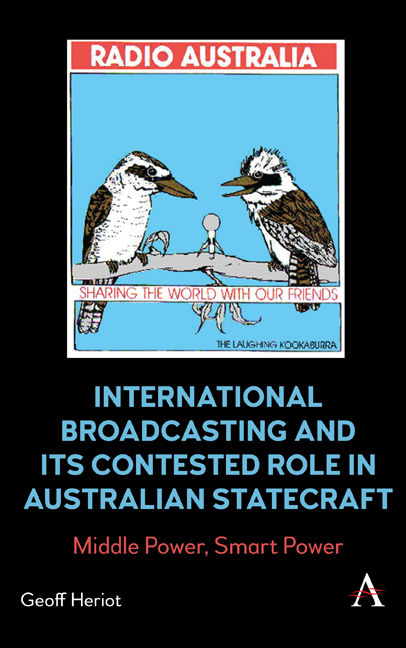 International Broadcasting and Its Contested Role in Australian Statecraft
International Broadcasting and Its Contested Role in Australian Statecraft Book contents
- Frontmatter
- Dedication
- Contents
- List of Figures
- Foreword
- Acknowledgements
- Chapter One Introduction
- Chapter Two Media and the Contest of Ideas
- Chapter Three International Broadcasting and Its Discursive Properties
- Chapter Four Mobilising ‘Softer’ Power in a Hard World
- Chapter Five Australia’s ABC: State Interests, National Evolution
- Chapter Six Purpose, Performance and Evaluation
- Chapter Seven Modernising the ABC
- Chapter Eight Policy, Priorities and Qualified Independence
- Chapter Nine Engaging with Intercultural Audiences
- Chapter Ten Indonesia, the Crucible
- Chapter Eleven Strategic Contingency and War
- Chapter Twelve Looking to the New Disorder
- Index
Chapter Twelve - Looking to the New Disorder
Published online by Cambridge University Press: 15 November 2023
- Frontmatter
- Dedication
- Contents
- List of Figures
- Foreword
- Acknowledgements
- Chapter One Introduction
- Chapter Two Media and the Contest of Ideas
- Chapter Three International Broadcasting and Its Discursive Properties
- Chapter Four Mobilising ‘Softer’ Power in a Hard World
- Chapter Five Australia’s ABC: State Interests, National Evolution
- Chapter Six Purpose, Performance and Evaluation
- Chapter Seven Modernising the ABC
- Chapter Eight Policy, Priorities and Qualified Independence
- Chapter Nine Engaging with Intercultural Audiences
- Chapter Ten Indonesia, the Crucible
- Chapter Eleven Strategic Contingency and War
- Chapter Twelve Looking to the New Disorder
- Index
Summary
In this book, I cast back to the Cold War era of international radio broadcasting, typified by global strategic competition and Asia–Pacific regional tumult. I did so with one eye squinched towards Australia’s ‘smart power’ challenge in today’s Indo-Pacific. Key findings about the political history of Radio Australia during the twentieth century, tested against the potentially timeless model framework proposed in Chapter 6, offer points of reference when interrogating contemporary practices of intercultural communication. The use or adaptation of this framework could assist in the development of a more purposeful and coherent application of discursive power than recent Australian governments have demonstrated.
The recurring propensity of governments to invest and disinvest in international broadcasting results from multiple causes, including vacillating perceptions of threat and opportunity over decades since the end of the Cold War. This inconstancy also dates from a period when neoliberal orthodoxy relegated geopolitics and the contest of global systems to the periphery; that is, until revisionist powers asserted themselves and sources of regional and global instability multiplied. Principally under centre-right governments, Australia responded by prioritising investment in hard power assets and security-inspired alliances or associations of the like-minded. First, these responses occurred in the context of post-9/11 US-led campaigns in the Middle East and Afghanistan, then in response to a more assertive China. In some measure, the yo-yoing of Australian policy mirrored the philosophical biases and shibboleths of whichever political coalition or party held office at points in time. Importantly – as this book argues – a more specific and outcome-oriented description of international broadcasting functions and deployment might assist in tempering the biases or disinclination of policymakers to consider the practice strategically.
Circumstances and the tactics of programme design and deployment necessarily will vary when directed to Australia’s innermost strategic perimeter of the southwest Pacific, where it exercises regional hegemony, compared with Indonesia and the other ascendant nations of Southeast Asia, and/or the outer reaches of North Asia and the eastern Indian Ocean. Across all three zones, Australia experiences the challenge of cultural divides, much more so than with its Western democratic interlocutors in Europe and America.
- Type
- Chapter
- Information
- International Broadcasting and Its Contested Role in Australian StatecraftMiddle Power, Smart Power, pp. 245 - 262Publisher: Anthem PressPrint publication year: 2023
